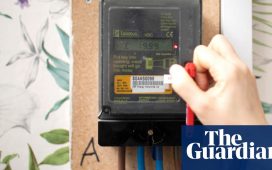An ambitious €350m (£300m) plan to connect electricity grids across the island of Ireland is heading for the high court after a challenge brought by campaigners claiming Northern Ireland was being used as a “whipping boy” to feed the republic’s energy-hungry datacentres.
An estimated 150 landowners representing 6,500 residents have called on the Northern Ireland minister for infrastructure, Liz Kimmins, to suspend the construction of more than 100 towering pylons in Armagh and Tyrone until a judicial review, due to start on 9 April, has been completed.
The legal challenge is the latest delay on the north-south interconnector, which was first conceived in 2006 as part of the post-peace collaboration between Belfast, Dublin and London.
Construction preparation on the pylon network has already begun but with planning permission due to expire in the autumn, a successful legal challenge could set back plans by years.
John Woods, the founder of Linwoods Health Foods, based in Armagh, who heads the campaign group Safe Electricity Armagh and Tyrone (SEAT), said the landowners want the cables placed underground, as they have been in sections of the network in the republic.
Their high court action centres on what they claim are breaches of planning compliance rules.
“Not only are there serious issues about the way in which local people have been treated through the process of trying to access private land but everyone must acknowledge the construction of these huge pylons carrying 400kW cables running through Armagh and Tyrone will blight the landscape, destroy beautiful scenery, damage the environment and reduce the values of homes and farmland,” Woods said.
The group also claims that the interconnector is facilitating weaknesses in the republic’s energy strategy, with 21% of electricity consumption going on datacentres.
“NI landowners are being used as the whipping boy for the long list of failed energy strategies in the Republic of Ireland over many years,” it said, arguing the huge consumption of energy by datacentres had pushed up demand over the border.
“There’s a fundamental question: what is the interconnector for? And what does it do for Northern Ireland? Nothing for Northern Ireland now or in the next decade, because all it will do is cream off, poach, steal, take for dirt money our renewable energy and sell it to the datacentres at added value money,” Woods said.
He claims the drive to connect Northern Ireland and the republic’s electricity is to allow Ireland to pursue “sucking power from Scotland” for deployment in Ireland “using NI as a land bridge”.
The System Operator for Northern Ireland (SONI), which operates NI’s energy grid, refused to comment on the judicial review proceedings but said Woods’s remarks about the purpose of the interconnector are inaccurate, unfair, and mischaracterise the interconnector.
It says the interconnector was “critical” to NI’s net zero targets as it would create infrastructure allowing the integration of renewable energy and enable it to sell surplus wind energy across the border that would otherwise be wasted.
One of the problems facing SONI and others drawing on windfarms is the short-lived nature of energy from renewable sources such as windfarms.
Energy created from high winds at night, for instance, may not be matched by the size of demand from consumers while they are still asleep. Battery technology is not yet advanced enough to store the energy for long periods of time, meaning it ends up being wasted.
The interconnector will remove these constraints, SONI said, because it will be enable surplus to go into the wider all-island energy grid.
after newsletter promotion
“The north-south interconnector will also remove significant constraints on the Northern Ireland transmission grid, enabling NI to use more of the renewable electricity it already generates. Removing these constraints will also save Northern Ireland consumers approximately £55,000 a day, £19m annually, in costly constraint payments,” the spokesperson said.
It also hit out at suggestions that Northern Ireland was being subsumed under the all-island single energy market strategy, saying it would never shift energy across the border if it was needed domestically. The home market would remain its priority, it added.
It said overhead cables were chosen over underground because it would enable access in the event of power outages.
Having them underground was too risky and could lead to lengthy repair times.
Subsea cables from Northern Ireland to Scotland and Ireland to Wales, as well as a planned interconnector between Ireland and France, allow energy flows across multiple countries to secure the future of EU and British supplies.
Jim Lennon, another campaign leader with SEAT, said the links between north and south were not the problem but that there was a legitimate need to review the cost after such a long time in the planning.
He also said swathes of land along a 21-mile stretch would be made into a planning and farming desert given the restrictions on development or use of land directly surrounding pylons.
The judicial review challenge was originally due to be heard on 19 February but was put back to 9 April at the request of Northern Ireland’s Department for Infrastructure (DfI) and SONI.
Neither SONI nor the DfI would comment on the court case.
A spokesperson for the DfI said the interconnector would bring “material benefits” to electricity consumers, business and domestic, and, critically, “facilitate the integration of more renewable electricity into our electricity system”.










